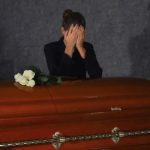 Miscellaneous
Miscellaneous  Miscellaneous
Miscellaneous  Our World
Our World 10 Green Practices That Actually Make a Difference
 Humans
Humans Ten Historic Men Who Deserve Way More Credit Than They Got
 Movies and TV
Movies and TV The 10 Most Heartwarming Moments in Pixar Films
 Travel
Travel Top 10 Religious Architectural Marvels
 Creepy
Creepy 10 Haunted Places in Alabama
 History
History Top 10 Tragic Facts about England’s 9 Days Queen
 Food
Food 10 Weird Foods Inspired by Your Favorite Movies
 Religion
Religion 10 Mind-Blowing Claims and Messages Hidden in the Bible Code
 Facts
Facts 10 Things You Never Knew about the History of Gambling
 Miscellaneous
Miscellaneous Ten Groundbreaking Tattoos with Fascinating Backstories
 Our World
Our World 10 Green Practices That Actually Make a Difference
 Humans
Humans Ten Historic Men Who Deserve Way More Credit Than They Got
Who's Behind Listverse?

Jamie Frater
Head Editor
Jamie founded Listverse due to an insatiable desire to share fascinating, obscure, and bizarre facts. He has been a guest speaker on numerous national radio and television stations and is a five time published author.
More About Us Movies and TV
Movies and TV The 10 Most Heartwarming Moments in Pixar Films
 Travel
Travel Top 10 Religious Architectural Marvels
 Creepy
Creepy 10 Haunted Places in Alabama
 History
History Top 10 Tragic Facts about England’s 9 Days Queen
 Food
Food 10 Weird Foods Inspired by Your Favorite Movies
 Religion
Religion 10 Mind-Blowing Claims and Messages Hidden in the Bible Code
 Facts
Facts 10 Things You Never Knew about the History of Gambling
10 Animals That Were Harmed in the Making of a Film
We are so used to the seemingly universal American Humane Association (AHA) declaration that “No animals were harmed in the making of this movie” that most of us take it for granted that this remains the case across all films designed for mainstream consumption. Not so.
In fact, there is a storied history of instances in which few or no safety measures were put in place, and animals were harmed on set in the process. Worse still, many productions always intended for some poor creature to lose their lives on camera. And, as a deep-dive into the topic uncovered, even when some films do get the AHA sign off, that doesn’t always mean it’s true.
https://www.hollywoodreporter.com/news/general-news/animals-were-harmed-hollywood-reporter-investigation-on-set-injury-death-cover-ups-659556/
Related: Top 10 Experimental Films to Watch Right Now
10 Rats—First Blood (1982)
The first film in the Sylvester Stallone-led series, First Blood, created an ’80s action icon in John Rambo, a maligned Vietnam veteran who is forced to face off against corrupt local law enforcement.
While there are all manner of onscreen deaths throughout the film, almost all of them—including the demise of several dogs—were created with a big helping of movie magic. Unfortunately, this can’t be said for the rats. Stuck in an abandoned mine, Rambo journeys his way to freedom, at one point moving through a tight space filled with rats. But when the rodents climb on his back, he snaps, grabbing them, crushing them, and mashing them against the walls.
AHA themselves reported that real rats were harmed and killed by Stallone in this process, not just on camera but between takes while the director and film crew watched. And when the AHA representative found herself unable to take action, she wrote to the Canadian Council on Animal Care who instructed her to “wait until the picture was released and point out the abuse to the Canadian Film Board.”[1]
9 Cockroach—Vampire’s Kiss (1988)
Director Robert Bierman may be the reason we have the weird and wacky Nicolas Cage we know today, all because he let him go wild in Vampire’s Kiss. The film offers up the pre-Patrick Bateman story of Peter Loew (Cage), a narcissistic yuppie losing touch with reality and winding up believing he’s a vampire. Never one to do things by half, Cage went as method as possible, staying in character between takes, chasing bats around Central Park, and eating cockroaches for breakfast.
In one scene, the script had Peter eat a raw egg yolk, which, while outside the bounds of normal behavior at the time, was not an egregious transgression in any sense. Recognizing the lack of power in this, Cage himself suggested something a little crunchier that would put audiences on edge—a real, live cockroach.
Producer Barbara Zitwer told him no, but after the film’s doctor gave it the okay, Bierman signed off on it, the production sourced some roaches, and Cage chowed them down on camera. Twice—the second time just to see how far the star would go.[2]
8 Pig & Goose—Weekend (1967)
French New Wave pioneer Jean-Luc Godard spent the mid-1960s producing some of the defining films of the era, and toward the decade’s conclusion, he was intent on seeing just how extreme his filmmaking could go. The result was Weekend, a difficult-to-define postmodern work that uses aspects of horror, absurdity, and social drama. It portrays a France where the entire nation suddenly, violently rejects the new consumer lifestyle.
A lot of the film is spent watching car crashes, literal and metaphoric, as quietly warring couple Roland and Corinne Durand (Mireille Darc and Jean Yanne) visit a countryside swallowed by revolution, brutality, and surreal vignettes. Toward the film’s conclusion, they are captured by a gang of cannibals, whose butcher kills, cuts, and cooks several people offscreen and a pig and goose right on-camera.
By far, these are the most unpleasant images of a film built from unpleasant images. The animals are fatally wounded and struggle to their deaths in fear. But why? Godard claimed it was because his audience would be more shocked by the death of a pig than the death of a human. We will hopefully never know if he was right.[3]
7 Horses—Jesse James (1939)
Despite its subject being a household name, Henry King’s Jesse James was a bit of a dud. Produced by 20th Century Fox and costing an unthinkable (at the time) $1.6 million, the western managed to bungle the outlaw’s story and was riddled with historical inaccuracies. Today, it’s remembered best as the film that introduced the AHA to Hollywood.
Westerns of the Golden Age were known for treating their prominently featured horses with little care or respect. As a result, the animals often sustained injuries on set. With no one designated to hold them to account, productions carried on like it was just business. However, after a sequence in Jesse James in which two horses were forced over a 70-foot cliff edge into the water below, resulting in their deaths, this all changed.
Accounts vary over whether the horses drowned from breaking their backs or because they panicked and were unable to swim, but whatever the case, widespread protests were mounted against the film. As a result, the Motion Picture Association of America allowed the AHA to oversee the use of animals in productions, and establish a set of guidelines for their correct treatment.[4]
6 Bees—Candyman (1992)
The urban legend born of a Clive Barker short story, Candyman became a horror sensation in the ’90s, with saying his name five times in the mirror becoming something of a yardstick for bravery across the Western world.
Apart from the character’s hooked hand and open chest, one of his most fearsome attributes in Bernard Rose’s original film is his ability to summon bees at will. CGI was in its early days, and seeking authenticity of the highest degree, Rose used 200,000 real honeybees for the film’s infamous scene where a swarm of bees spills from Candyman’s mouth.
Tony Todd, who played Candyman, admitted to being stung 27 times while filming, which is bad enough in itself. However, as these were live honeybees, all 27 of them died after stinging the actor. The honeybee’s stings are designed to be used against other insects rather than large mammals, and the fibrous nature of human skin prevents the barbed stinger from being released afterward. This causes the bee’s abdomen to be torn open when it attempts to pull away, gutting and killing it.[5]
5 Rabbit—Nekromantik (1987)
Nekromantik has held a place of infamy in the film world since its late-1980s release due to its obsession with, and portrayal of, necrophilia. Nonetheless, it has built something of a cult following in the years since, capitalizing on its taboo content and endearing itself to fans who go in for schlocky effects (including real animal intestines) and the undeniable silliness of it all.
In the film, crime scene clean-up guy Robert Schmadtke (Bernd Daktari Lorenz) brings home a corpse for him and his wife (Beatrice Manowski’s Betty) to make love with, but is soon threatened by her sexual preference for the dead. So far, so strange.
Unfortunately, director Jörg Buttgereit was intent on putting real death into his film and, short of access to any actors willing to die for his art, opted for an animal instead. Buttgereit filmed a rabbit being killed and skinned to, in his own words, “make people aware of what they’re watching, and to make people sensitive about why they’re watching it. Because… sooner or later, you will begin to ask yourself, why am I watching this?” Indeed.[6]
4 Goat & Donkey—Land without Bread (1933)
While he may be one of the most influential directors of all time, Luis Bunuel hit some low points in his career that most of the film world would rather forget. One, in particular, is his documentary Land without Bread, which depicts Spain’s Las Hurdes region and the overwhelming poverty of its people, who lacked amenities such as roads, electricity, and, of course, bread.
Except, at least in part, they didn’t. Although Land without Bread gave the impression of a place riddled with poverty, disease, and death, many of the film’s scenes were staged to look worse than they actually were. This included a goat falling from a cliff to its death to demonstrate the treacherous landscape and a donkey being stung to death by bees, showing the brutal nature of life in this community.
Considering how much of the documentary is staged, it wouldn’t have hurt Bunuel to use dummies instead of animals. Instead, he filmed these contrived scenes for real, shooting the goat off the cliffside and smearing the donkey in honey before kicking over two beehives.[7]
3 Octopus—Oldboy (2003)
Korean cinema experienced a major boost in the late 1990s and into the 2000s as censorship eased. The country’s directors saw the opportunity to do some pretty extreme things that had never been committed to film before. And the crowning jewel of this boom is Park Chan-wook’s Oldboy.
The iconic action thriller sees Choi Min-sik’s Oh Dae-su released from confinement after 15 years inside. At this point, he embarks on a quest for bloody vengeance and answers to who kidnapped him and why. But first, he stops off at a sushi restaurant to begin his journey with a meal: live octopus.
It should come as no surprise to discover Choi chewed the head off a real live octopus—or, in fact, several live octopuses. In practice takes, the actor had the opportunity to perfect his technique on a series of other live cephalopods. Each time, he tore their head from their body with his teeth and held their squirming legs aloft before discarding their remains into a spit bucket off camera. While raw octopus may be considered a delicacy in South Korea, live octopus definitely isn’t.[8]
2 Muskrat, Monkeys, Giant Sea Turtle & Others—Cannibal Holocaust (1980)
Infamous cannibal exploitation mockumentary Cannibal Holocaust has been banned in countries across the world since its release. Given its visceral content that often appears to be real, it’s not difficult to see why. Filmed in the Amazon rainforest with a cast comprising indigenous tribes and inexperienced actors, the film is a grim descent into graphic violence that appears to show the actors being killed on camera.
While the cast made it out unharmed, the same cannot be said for the non-human animals. Throughout the film, there is rampant cruelty and slaughter, with a massive death toll of animals by the time production finished, including the killing and dismembering of a giant sea turtle—an endangered animal fiercely protected by most global nations.
Despite the backlash from the public, the press, and the film’s actors, director Ruggero Deodato remained largely unrepentant when questioned on it. He claimed he only included these scenes because it was what the “Oriental market” wanted to see. Still, to see the lengths the production went to kill so many animals, there can be no doubt this was conducted by someone who very much wanted to do it.[9]
1 Cow—Cow (2021)
Indie auteur Andrea Arnold sought to present the English farm in all its dimensions in Cow. She made a conscious decision to court realism and transparency throughout her four years of filming and attached no overt political statements to the final product—allowing audiences to make up their own minds on the evidence of their eyes.
Filmed at Park Farm in Kent, Cow takes us through the life of Luma, a dairy cow. Arnold operated without a script, allowing the moments to create themselves and capturing the highs, lows, and abiding consciousness of the cow’s life in an observational, cinéma vérité style. Nothing is withheld when Luma is inseminated, calves, and has her babies taken from her, when she frolics in the fields and is confined to tight spaces for months, and when she is killed, having outgrown her use.
At the film’s conclusion, Luma is shot in the head by a farmer wielding a captive bolt gun—a common tool used for slaughtering animals—ready to be skinned, bled, and made into products for general consumption, in the same way that 900,000 of her species are every day of the year.[10]








